“This is what victory looks like in the Iraqi city of Ramadi: In the once thriving Haji Ziad Square, not a single structure still stands. Turning in every direction yields a picture of devastation. A building that housed a pool hall and ice cream shops – reduced to rubble. A row of money changers and motorcycle repair garages – obliterated, a giant bomb crater in its place. The square's Haji Ziad Restaurant, beloved for years by Ramadi residents for its grilled meats – flattened. The restaurant was so popular its owner built a larger, fancier branch across the street three years ago. That, too, is now a pile of concrete and twisted iron rods. The destruction extends to nearly every part of Ramadi, once home to 1 million people and now virtually empty. A giant highway cloverleaf at the main entrance to the city is partially toppled. Apartment block after apartment block has been crushed. Along a residential street, the walls of homes have been shredded away, exposing furniture and bedding. Graffiti on the few homes still standing warn of explosives inside.
When Iraqi government forces backed by U.S.-led warplanes wrested this city from Islamic State militants after eight months of IS control, it was heralded as a major victory. But the cost of winning Ramadi has been the city itself. The scope of the damage is beyond any of the other Iraqi cities recaptured so far from the jihadi group. Photographs provided to The Associated Press by satellite imagery and analytics company DigitalGlobe show more than 3,000 buildings and nearly 400 roads and bridges were damaged or destroyed between May 2015, when Ramadi fell to IS, and January 22, after most of the fighting had ended. Over roughly the same period, nearly 800 civilians were killed in clashes, airstrikes and executions. As a result, U.S.-led coalition and Iraqi officials are rethinking their tactics as they battle IS to regain territory. The coalition is scaling back its airstrikes in besieged urban areas. Efforts are underway to increase training of explosive disposal teams. The new approach is particularly key as Iraq and the coalition build up to the daunting task of retaking Mosul, Iraq's second-biggest city, held by IS for nearly two years”. – Susannah George, Desmond Butler and Maya Alleruzzo via The Associated Press
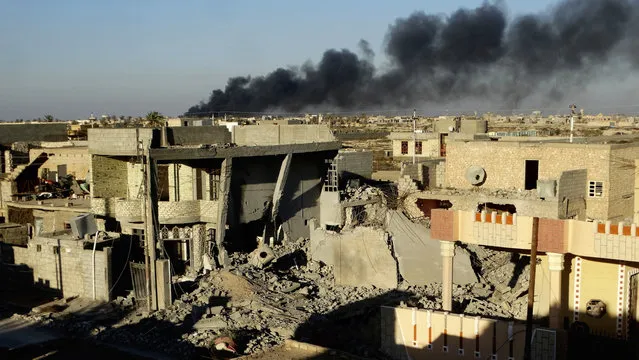
Smoke rises from Islamic State group positions after an airstrike by U.S.-led coalition warplanes in the Iraqi city of Ramadi in this December 25, 2015 file photo during the Iraqi government offensive that drove the militants out of the city. Ramadi, the provincial capital of Iraq's Sunni heartland, was declared “fully liberated” early this year. But the cost of victory may have been the city itself, with widespread destruction from strikes, artillery and the militants' scorched earth tactic of destroying buildings and infrastructure as they fled. (Photo by AP Photo)
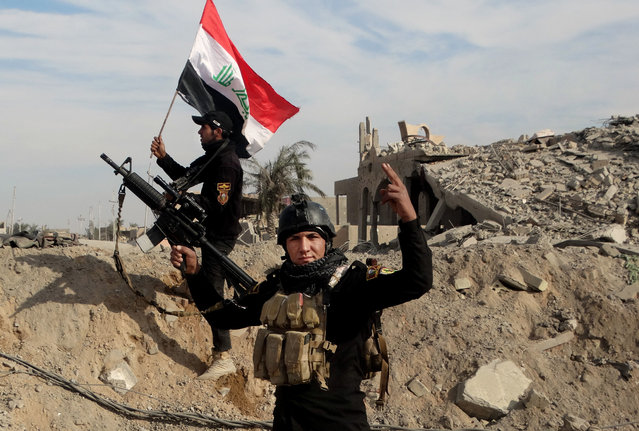
Iraqi counterterrorism soldiers raise an Iraqi flag on the ruins of a building near the provincial council headquarters in Ramadi in this December 27, 2015 file photo, during the offensive that freed the Iraqi city from nearly a year of rule by the Islamic State group. Satellite photos show the price that months of fighting wreaked on the city: More than 3,000 buildings and nearly 400 roads and bridges damaged or destroyed, with whole city blocks wiped out in some cases, from airstrikes, fighting or intentional destruction by the militants. (Photo by Osama Sami/AP Photo)
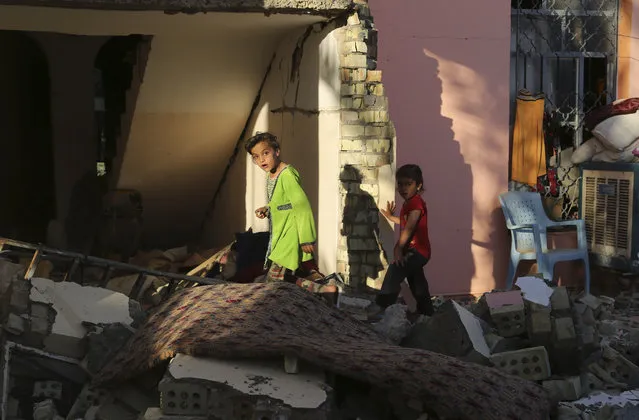
Jinat Ali, 7, left, and her sister Aya Ali, 5, pick their way through the rubble of their destroyed home in the western Iraqi city of Ramadi on April 3, 2016. Months after U.S.-based Iraqi forces freed the city from the control of the Islamic State group, the vast majority of Ramadi's population of 1 million remain displaced after the extensive destruction wreaked on the city during months of fighting. (Photo by Khalid Mohammed/AP Photo)
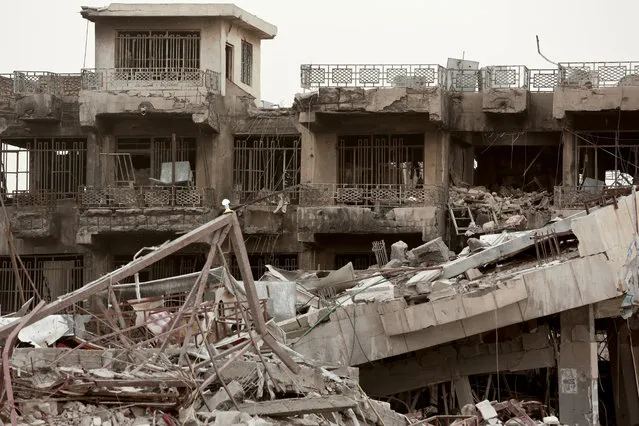
Two buildings in Haji Ziad Square in of the Iraqi city of Ramadi show extensive damage in this March 20, 2016, photo, months after U.S.-backed Iraqi forces freed the city from the Islamic State group. More than 3,000 buildings and nearly 400 roads and bridges were damaged or destroyed, and whole city blocks wiped out in some cases, by airstrikes, fighting or intentional destruction by the militants. The massive destruction is forcing officials from Iraq and the U.S.-led coalition to rethink tactics as they move to retake other cities from the militants. (Photo by Maya Alleruzzo/AP Photo)
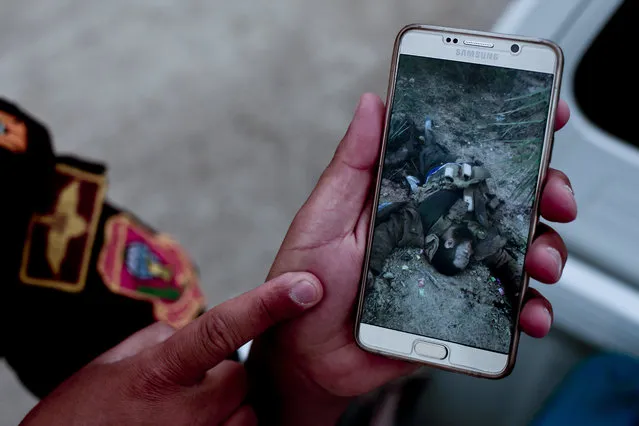
In this March 20, 2016 photo, Maj. Mohammed Hussein, an officer with Iraq's elite counterterrorism forces, shows a photo of a slain Islamic State group militant still wearing in a suicide vest, taken during fighting that freed the city of Ramadi from IS control earlier this year. As they fled, the militants destroyed some buildings and booby-trapped others with explosives, leaving behind an empty prize for government forces retaking the city. (Photo by Maya Alleruzzo/AP Photo)
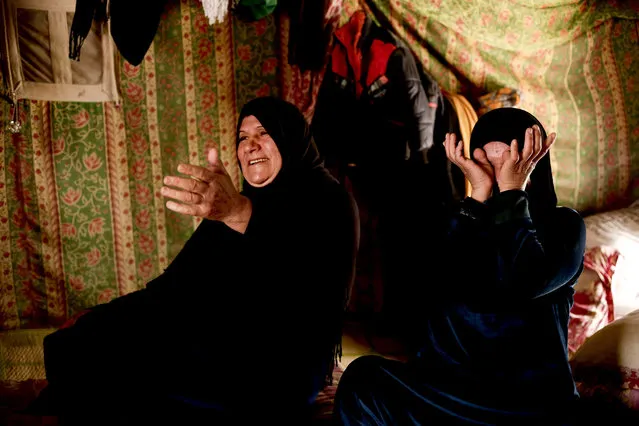
Samira Ouda Faris, left, and Fawzia Khalil Brahim laugh and cry on March 21, 2016, as they recount the day when they heard Iraqi forces had wrested control of their home city of Ramadi from Islamic State group militants. The women and their families, including 11 children, live in a small tent in a camp for displaced people in the nearby town of Habbaniyah. Nearly all of Ramadi's population of 1 million remains displaced months after the city's recapture because of the vast destruction wreaked by months of fighting there. (Photo by Maya Alleruzzo/AP Photo)
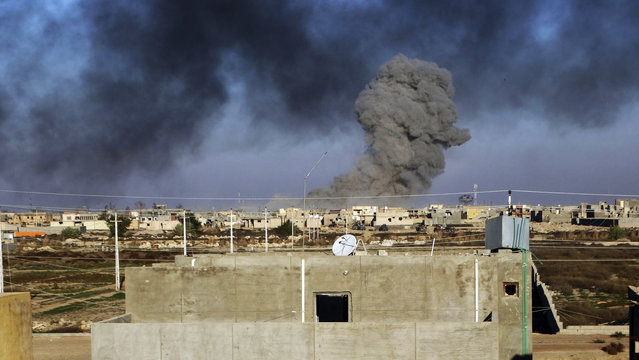
Smoke rises from Islamic State group positions after an airstrike by U.S.-led coalition warplanes in the Iraqi city of Ramadi in this December 25, 2015 file photo taken during the Iraqi government offensive that drove the militants out of the city. During months of fighting, the U.S.-led coalition dropped more than 600 bombs on the city, artillery pounded districts and retreating militants unleashed a scorched earth policy destroying buildings – all contributing to vast destruction. (Photo by AP Photo)
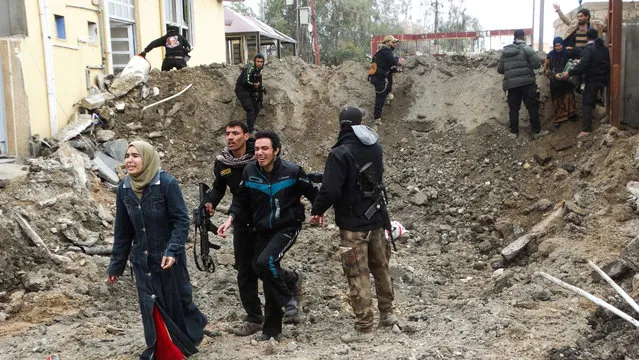
Iraqi security forces and Sunni tribal fighters help trapped civilians cross out of neighborhoods under Islamic State group control in Ramadi in this January 4, 2016, file photo. As they fled the city earlier this year, IS militants methodically destroyed buildings, infrastructure, bridges and dams in a scorched earth tactic that Iraq and U.S. officials fear they will use as they come under attack in other cities, particularly Mosul. (Photo by AP Photo)
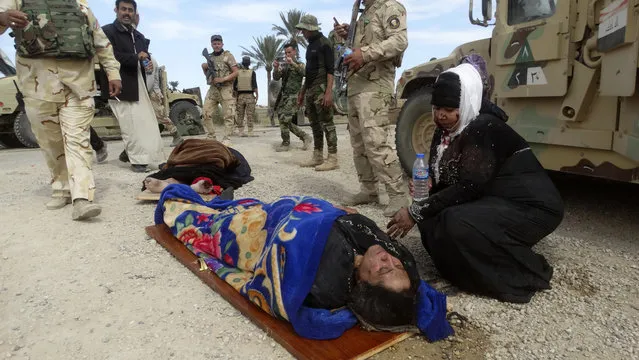
An injured woman comforts another as they wait for treatment after clashes between Iraqi forces and Islamic State group extremists in a village outside Ramadi, in this March 9, 2016 file photo. Months after Iraqi troops wrested control of Ramadi from the militants, most of the city's population of 1 million remains displaced, unable to return because of continued fighting in surrounding areas and massive destruction. (Photo by Osama Sami/AP Photo)
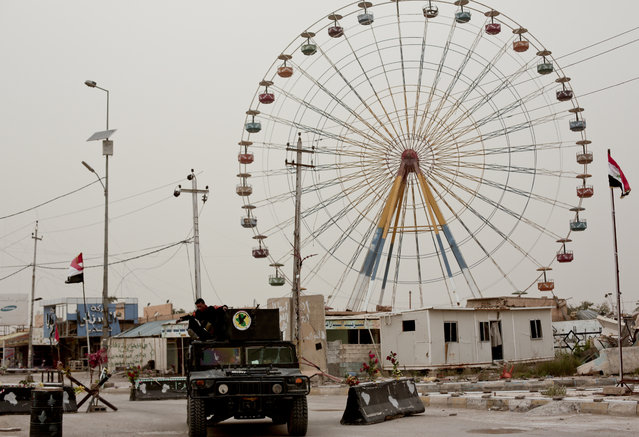
Iraqi counterterrorism forces drive past a ferris wheel in a central district of Ramadi on March 20, 2016. Months after being wrested from the control of the Islamic State group, Ramadi remains devastated with no running water or electricity, entire residential blocks destroyed and no clear picture on when or how it can be rebuilt. (Photo by Maya Alleruzzo/AP Photo)
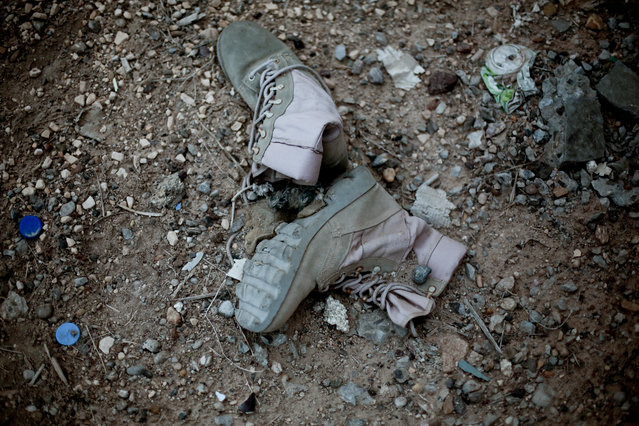
Combat boots lie in the dirt on March 20, 2016, in Ramadi, left behind after a battle weeks earlier between Islamic State group militants and Iraqi security forces. As they fled Ramadi earlier this year, the militants destroyed some buildings and booby-trapped others with explosives in a scorched earth tactic that left behind an empty prize for government forces retaking the city. (Photo by Maya Alleruzzo/AP Photo)
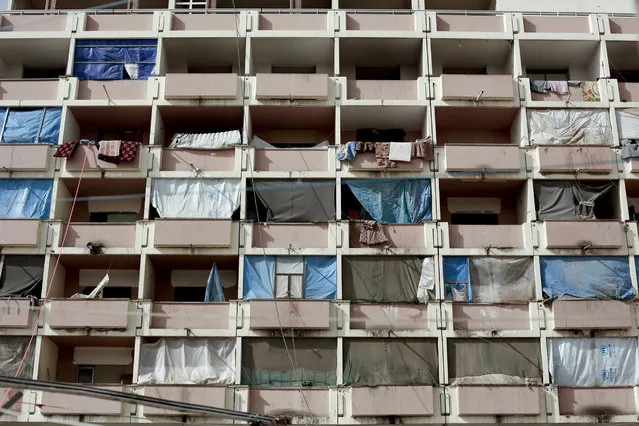
A hotel on the shore of Iraq's Lake Habbaniya, shown in this March 21, 2016 photo, now shelters thousands of families who fled the Islamic State group in Anbar province, including the provincial capital of Ramadi. Months after Ramadi was retaken from the militants, most of its 1 million residents have not returned because of the widespread destruction of their homes, and some say their savings are running out, leaving them dependent on aid handouts. (Photo by Maya Alleruzzo/AP Photo)
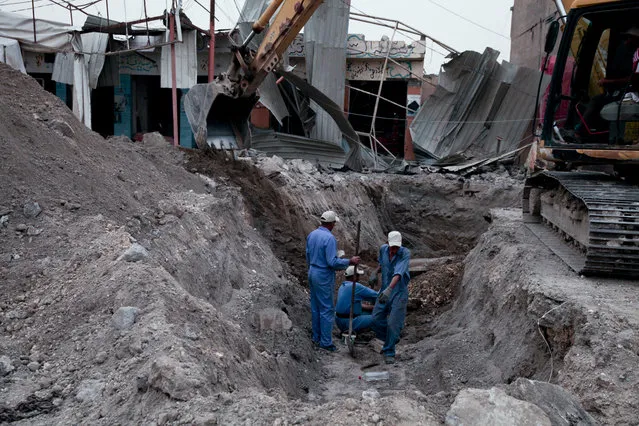
Iraqi workers dig a trench for a new water pipe near Haji Ziad square in the center of Ramadi on March 20, 2016. Months after the city was freed from Islamic State group control, reconstruction has hardly begun in Ramadi, where entire city blocks were leveled and infrastructure was smashed in months of fighting, illustrating the giant task Iraq will face as it recaptures more cities from the extremists. (Photo by Maya Alleruzzo/AP Photo)
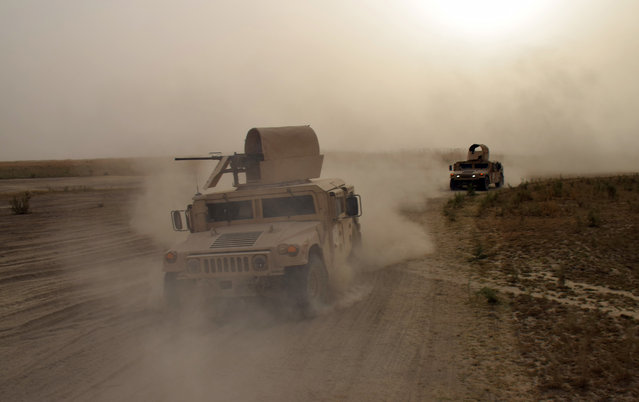
Iraqi army Humvees race toward the front lines on the outskirts of Ramadi during heavy clashes with Islamic State group militants in this September 12, 2015, file photo. The fighting eventually led to the recapture of the city from the extremists. After the massive destruction wreaked on Ramadi, Iraqi and coalition officials are rethinking tactics as they prepare for an assault to retake the biggest IS-held prize, the northern city of Mosul. (Photo by AP Photo)
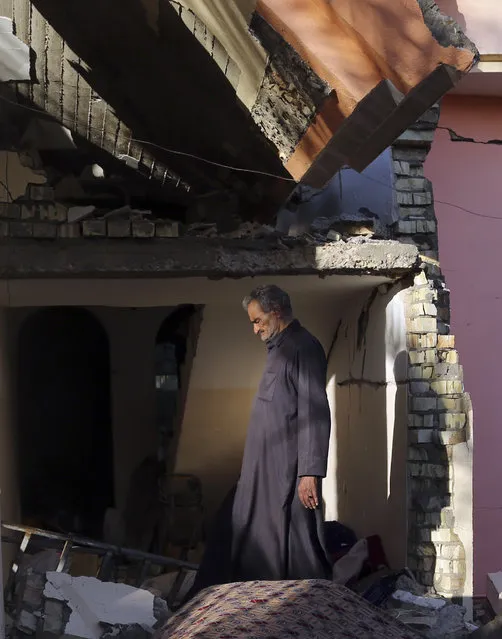
Hussein Jassim walks through the ruins of his house in the Iraqi city of Ramadi on April 3, 2016, months after the city was retaken from Islamic State group control. More than 3,000 buildings were destroyed and damaged in fighting or by scorched earth tactics by the militants. For many residents, their homes represented their entire life's savings, and few have the means to rebuild, presenting a massive reconstruction task for an overburdened Iraqi government. (Photo by Khalid Mohammed/AP Photo)
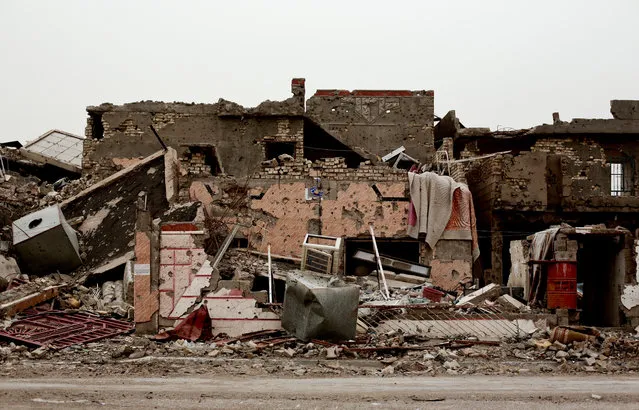
A family house lies in ruins in the Iraqi city of Ramadi on March 20, 2016, weeks after the city was retaken from the Islamic State group. Entire city blocks were leveled by fighting, airstrikes and by the militants themselves, deliberately blowing up buildings as they fled. For many residents, their homes represented their entire life's savings, and few have the means to rebuild, presenting a massive reconstruction task for an overburdened Iraqi government. (Photo by Maya Alleruzzo/AP Photo)
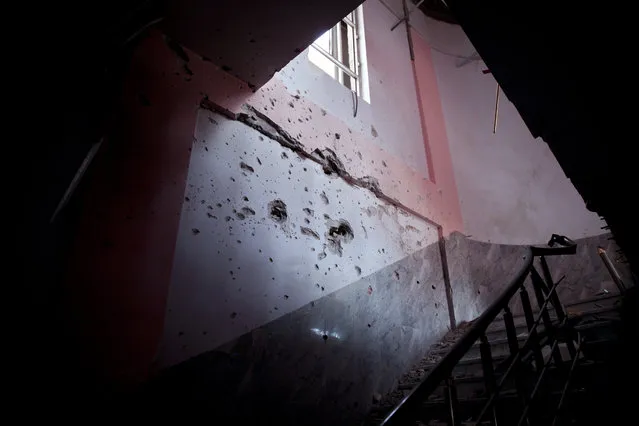
A stairwell at the library of the University of Anbar in the Iraqi city of Ramadi shows heavy damage in this March 20, 2016 photo. The campus served as headquarters for the Islamic State group before Iraqi forces retook the city earlier this year. As they retreated, the militants set fires in some university buildings and blew up others. (Photo by Maya Alleruzzo/AP Photo)
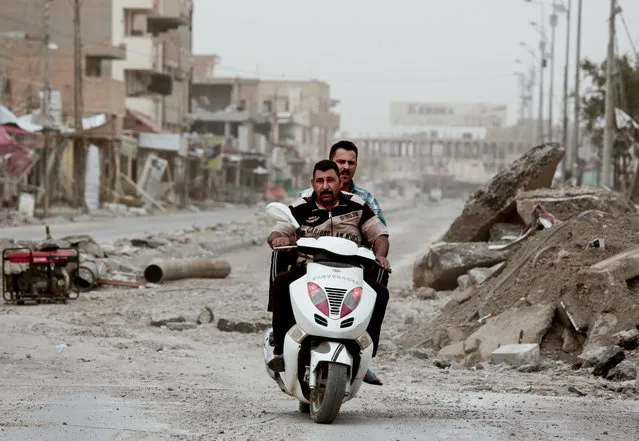
Policemen ride a motorbike near Haji Ziad Square in the city of Ramadi, Iraq, on March 20, 2016, passing rubble that remains weeks after government forces retook the city from Islamic State group militants. Entire city blocks were leveled by fighting, airstrikes and the scorched earth campaign waged by militants as they fled. “All they leave is rubble”, one counterterrorism officer said. (Photo by Maya Alleruzzo/AP Photo)
When Iraqi government forces backed by U.S.-led warplanes wrested this city from Islamic State militants after eight months of IS control, it was heralded as a major victory. But the cost of winning Ramadi has been the city itself. The scope of the damage is beyond any of the other Iraqi cities recaptured so far from the jihadi group. Photographs provided to The Associated Press by satellite imagery and analytics company DigitalGlobe show more than 3,000 buildings and nearly 400 roads and bridges were damaged or destroyed between May 2015, when Ramadi fell to IS, and January 22, after most of the fighting had ended. Over roughly the same period, nearly 800 civilians were killed in clashes, airstrikes and executions. As a result, U.S.-led coalition and Iraqi officials are rethinking their tactics as they battle IS to regain territory. The coalition is scaling back its airstrikes in besieged urban areas. Efforts are underway to increase training of explosive disposal teams. The new approach is particularly key as Iraq and the coalition build up to the daunting task of retaking Mosul, Iraq's second-biggest city, held by IS for nearly two years”. – Susannah George, Desmond Butler and Maya Alleruzzo via The Associated Press

Smoke rises from Islamic State group positions after an airstrike by U.S.-led coalition warplanes in the Iraqi city of Ramadi in this December 25, 2015 file photo during the Iraqi government offensive that drove the militants out of the city. Ramadi, the provincial capital of Iraq's Sunni heartland, was declared “fully liberated” early this year. But the cost of victory may have been the city itself, with widespread destruction from strikes, artillery and the militants' scorched earth tactic of destroying buildings and infrastructure as they fled. (Photo by AP Photo)

Iraqi counterterrorism soldiers raise an Iraqi flag on the ruins of a building near the provincial council headquarters in Ramadi in this December 27, 2015 file photo, during the offensive that freed the Iraqi city from nearly a year of rule by the Islamic State group. Satellite photos show the price that months of fighting wreaked on the city: More than 3,000 buildings and nearly 400 roads and bridges damaged or destroyed, with whole city blocks wiped out in some cases, from airstrikes, fighting or intentional destruction by the militants. (Photo by Osama Sami/AP Photo)

Jinat Ali, 7, left, and her sister Aya Ali, 5, pick their way through the rubble of their destroyed home in the western Iraqi city of Ramadi on April 3, 2016. Months after U.S.-based Iraqi forces freed the city from the control of the Islamic State group, the vast majority of Ramadi's population of 1 million remain displaced after the extensive destruction wreaked on the city during months of fighting. (Photo by Khalid Mohammed/AP Photo)

Two buildings in Haji Ziad Square in of the Iraqi city of Ramadi show extensive damage in this March 20, 2016, photo, months after U.S.-backed Iraqi forces freed the city from the Islamic State group. More than 3,000 buildings and nearly 400 roads and bridges were damaged or destroyed, and whole city blocks wiped out in some cases, by airstrikes, fighting or intentional destruction by the militants. The massive destruction is forcing officials from Iraq and the U.S.-led coalition to rethink tactics as they move to retake other cities from the militants. (Photo by Maya Alleruzzo/AP Photo)

In this March 20, 2016 photo, Maj. Mohammed Hussein, an officer with Iraq's elite counterterrorism forces, shows a photo of a slain Islamic State group militant still wearing in a suicide vest, taken during fighting that freed the city of Ramadi from IS control earlier this year. As they fled, the militants destroyed some buildings and booby-trapped others with explosives, leaving behind an empty prize for government forces retaking the city. (Photo by Maya Alleruzzo/AP Photo)

Samira Ouda Faris, left, and Fawzia Khalil Brahim laugh and cry on March 21, 2016, as they recount the day when they heard Iraqi forces had wrested control of their home city of Ramadi from Islamic State group militants. The women and their families, including 11 children, live in a small tent in a camp for displaced people in the nearby town of Habbaniyah. Nearly all of Ramadi's population of 1 million remains displaced months after the city's recapture because of the vast destruction wreaked by months of fighting there. (Photo by Maya Alleruzzo/AP Photo)

Smoke rises from Islamic State group positions after an airstrike by U.S.-led coalition warplanes in the Iraqi city of Ramadi in this December 25, 2015 file photo taken during the Iraqi government offensive that drove the militants out of the city. During months of fighting, the U.S.-led coalition dropped more than 600 bombs on the city, artillery pounded districts and retreating militants unleashed a scorched earth policy destroying buildings – all contributing to vast destruction. (Photo by AP Photo)

Iraqi security forces and Sunni tribal fighters help trapped civilians cross out of neighborhoods under Islamic State group control in Ramadi in this January 4, 2016, file photo. As they fled the city earlier this year, IS militants methodically destroyed buildings, infrastructure, bridges and dams in a scorched earth tactic that Iraq and U.S. officials fear they will use as they come under attack in other cities, particularly Mosul. (Photo by AP Photo)

An injured woman comforts another as they wait for treatment after clashes between Iraqi forces and Islamic State group extremists in a village outside Ramadi, in this March 9, 2016 file photo. Months after Iraqi troops wrested control of Ramadi from the militants, most of the city's population of 1 million remains displaced, unable to return because of continued fighting in surrounding areas and massive destruction. (Photo by Osama Sami/AP Photo)

Iraqi counterterrorism forces drive past a ferris wheel in a central district of Ramadi on March 20, 2016. Months after being wrested from the control of the Islamic State group, Ramadi remains devastated with no running water or electricity, entire residential blocks destroyed and no clear picture on when or how it can be rebuilt. (Photo by Maya Alleruzzo/AP Photo)

Combat boots lie in the dirt on March 20, 2016, in Ramadi, left behind after a battle weeks earlier between Islamic State group militants and Iraqi security forces. As they fled Ramadi earlier this year, the militants destroyed some buildings and booby-trapped others with explosives in a scorched earth tactic that left behind an empty prize for government forces retaking the city. (Photo by Maya Alleruzzo/AP Photo)

A hotel on the shore of Iraq's Lake Habbaniya, shown in this March 21, 2016 photo, now shelters thousands of families who fled the Islamic State group in Anbar province, including the provincial capital of Ramadi. Months after Ramadi was retaken from the militants, most of its 1 million residents have not returned because of the widespread destruction of their homes, and some say their savings are running out, leaving them dependent on aid handouts. (Photo by Maya Alleruzzo/AP Photo)

Iraqi workers dig a trench for a new water pipe near Haji Ziad square in the center of Ramadi on March 20, 2016. Months after the city was freed from Islamic State group control, reconstruction has hardly begun in Ramadi, where entire city blocks were leveled and infrastructure was smashed in months of fighting, illustrating the giant task Iraq will face as it recaptures more cities from the extremists. (Photo by Maya Alleruzzo/AP Photo)

Iraqi army Humvees race toward the front lines on the outskirts of Ramadi during heavy clashes with Islamic State group militants in this September 12, 2015, file photo. The fighting eventually led to the recapture of the city from the extremists. After the massive destruction wreaked on Ramadi, Iraqi and coalition officials are rethinking tactics as they prepare for an assault to retake the biggest IS-held prize, the northern city of Mosul. (Photo by AP Photo)

Hussein Jassim walks through the ruins of his house in the Iraqi city of Ramadi on April 3, 2016, months after the city was retaken from Islamic State group control. More than 3,000 buildings were destroyed and damaged in fighting or by scorched earth tactics by the militants. For many residents, their homes represented their entire life's savings, and few have the means to rebuild, presenting a massive reconstruction task for an overburdened Iraqi government. (Photo by Khalid Mohammed/AP Photo)

A family house lies in ruins in the Iraqi city of Ramadi on March 20, 2016, weeks after the city was retaken from the Islamic State group. Entire city blocks were leveled by fighting, airstrikes and by the militants themselves, deliberately blowing up buildings as they fled. For many residents, their homes represented their entire life's savings, and few have the means to rebuild, presenting a massive reconstruction task for an overburdened Iraqi government. (Photo by Maya Alleruzzo/AP Photo)

A stairwell at the library of the University of Anbar in the Iraqi city of Ramadi shows heavy damage in this March 20, 2016 photo. The campus served as headquarters for the Islamic State group before Iraqi forces retook the city earlier this year. As they retreated, the militants set fires in some university buildings and blew up others. (Photo by Maya Alleruzzo/AP Photo)

Policemen ride a motorbike near Haji Ziad Square in the city of Ramadi, Iraq, on March 20, 2016, passing rubble that remains weeks after government forces retook the city from Islamic State group militants. Entire city blocks were leveled by fighting, airstrikes and the scorched earth campaign waged by militants as they fled. “All they leave is rubble”, one counterterrorism officer said. (Photo by Maya Alleruzzo/AP Photo)
05 May 2016 12:57:00,
post received
0 comments
